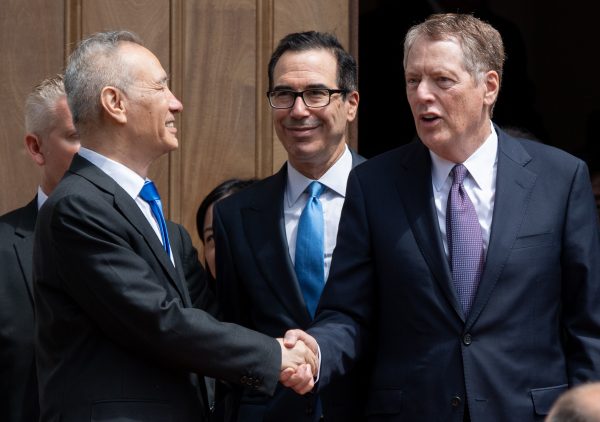US Trade Representative Announces Plan to Launch Online Portal for Comments on China Trade Act
Distressed Patriotic Flag Unisex T-Shirt - Celebrate Comfort and Country $11.29 USD Get it here>>

The Office of the United States Trade Representative (USTR) announced plans for opening an online portal for public comments for the statutory four-year review of China 301 Tariffs.
USTR plans to open an online portal, https://comments.USTR.gov, to the public on Nov. 15, for comments from interested parties.
In May, USTR issued steps in commencing the statutory four-year review of the two tariff actions that went effective, respectively, on July 6, 2018 and Aug. 23, 2018, taken under Section 301 of the Trade Act of 1974.
Step one was for domestic industries that benefit from the tariffs to submit a request for continuation of the two actions in the 60-day window prior to the four-year anniversary of the respective action.
In September, USTR announced that the two actions would remain in effect because “at least one representative of a domestic industry which benefits from each action” submitted a request for their continuation.
Under Section 301 of the Trade Act of 1974, USTR investigated and addressed China’s unreasonable or discriminatory acts, policies, and practices related to technology transfer, intellectual property, and innovation to burden or restrict U.S. commerce.
Online Submission of Comments
USTR invites comments on specific questionnaires such as the effects of the actions on U.S. economy and consumers, as well as the U.S. workers, small businesses, supply chain, manufacturing, technological leadership and development, etc.
A copy of questions for the docket will be ready by Nov. 1 to facilitate preparation of comments prior to the opening of the web portal.
According to the release, all comments must be submitted through the online portal. To be assured of consideration in this stage of the four-year review, interested parties should submit comments no later than Jan. 17, 2023.

The Tariffs
In response to China’s unfair trade practices, the Trump administration conducted a Section 301 investigation into China’s economic practices and imposed tariffs on certain unfairly priced Chinese imports in 2018.
A total of approximately $360 billion in Chinese goods were subject to additional tariffs—$120 billion worth of Chinese goods at 7.5 percent and $250 billion worth of Chinese goods at 25 percent.
In a release by USTR in June 2018, then-USTR representative Robert Lighthizer addressed the tariffs as “strong defensive actions to protect America’s leadership in technology and innovation” against China’s theft of U.S. intellectual property, the forced transfer of American technology, and its cyber attacks on the U.S. computer networks.

In a telephonic press briefing on Sept. 18, the incumbent USTR representative, Katherine Tai emphasized that the tariffs are not punitive in nature.
Tai referred to the tariffs as “rebalancing tariffs.”
She said, “[T]hey are tariffs to try to level the playing field to overcome unfairness that we have seen and the impacts on the U.S. economy.”
Wang Xiang contributed to this report.





